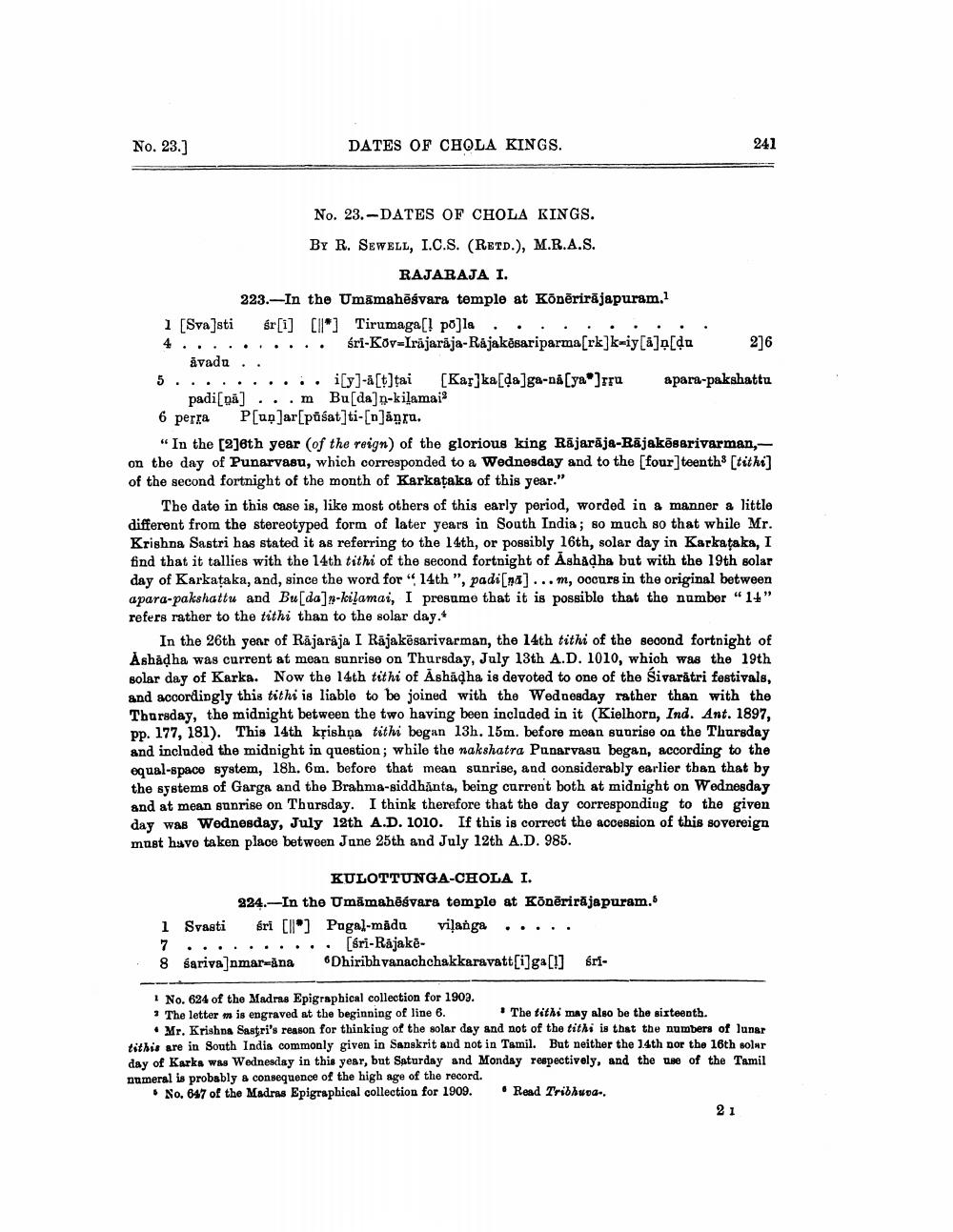________________
No. 23.]
DATES OF CHOLA KINGS.
241
No. 23.-DATES OF CHOLA KINGS. BY R. SEWELL, I.C.S. (Retd.), M.R.A.S.
RAJARAJA I. 223.-In the Umamahēsvara temple at Kõnērirājapuram. 1 [Sva]sti śr[i] [ll*) Tirumaga[! po]la 4.......... sri-Köv=Irajaraja-Rajakesariparma[rk]k-iy[á]n[du 276
åvadu.. 5 ........i i[y]-a[t]țai [Kar]ka[da]ga-nāsya]ru apara-pakshattu
padi pā] ...m Bu[da]n-kilamai 6 persa P[an]ar[pāśat]ti-[n]ágra.
"In the [2]6th year of the reign) of the glorious king Rājarāja-Rājakõsarivarman,on the day of Punarvasu, which corresponded to a Wednesday and to the [four]teenth> [tithi] of the second fortnight of the month of Karkataka of this year."
The date in this case is, like most others of this early period, worded in a manner a little different from the stereotyped form of later years in South India; so much so that while Mr. Krishna Sastri has stated it as referring to the 14th, or possibly 16th, solar day in Karkataka, I find that it tallies with the 14th tithi of the second fortnight of Ashadha but with the 19th solar day of Karkataka, and, since the word for " 14th ", padi[ma] ...m, occurs in the original between a para-pakshattu and Bu[da]m-kilamai, I presume that it is possible that the number "14" refers rather to the tithi than to the solar day.
In the 26th year of Rajaraja I Räjakësarivarman, the 14th tithi of the second fortnight of Ashādha was current at mean sunrise on Thursday, July 13th A.D. 1010, which was the 19th solar day of Karka. Now the 14th tithi of Ashādha is devoted to one of the Sivaratri festivals, and accordingly this tithi is liable to be joined with the Wednesday rather than with the Thursday, the midnight between the two having been included in it (Kielhorn, Ind. Ant. 1897, pp. 177, 181). This 14th kfisha tithi began 13h. 15m. before mean sunrise on the Thursday and included the midnight in question; while the nakshatra Panarvasu began, according to the equal-space system, 18h. 6m. before that mean sunrise, and considerably earlier than that by the systems of Garga and the Brahma-siddhanta, being current both at midnight on Wednesday and at mean sunrise on Thursday. I think therefore that the day corresponding to the given day was Wednesday, July 12th A.D. 1010. If this is correct the accession of this sovereign must have taken place between Jane 25th and July 12th A.D. 985.
KULOTTUNGA-CHOLA I. 224.--In the Umāmahēsvara temple at Könērirājapuram. 1 Svasti eri [ll] Pugal-mādu viļanga ..... 7 .......... [sri-Rajake8 sariva]nmar-ina Dhiribh vanachchakkaravatt[i]ga[:] fri
I No. 624 of the Madras Epigraphical collection for 1903. The letter m is engraved at the beginning of line 6.
The tithi may also be the sixteenth. • Mr. Krishna Sastri's reason for thinking of the solar day and not of the tithi is that the numbers of lunar tithio are in South India commonly given in Sanskrit and not in Tamil. But neither the 34th nor the 16th solar day of Karks was Wednesday in this year, but Saturday and Monday respectively, and the use of the Tamil numeral is probably & consequence of the high age of the record. No. 647 of the Madras Epigraphical collection for 1909. Read Tribhuva..
21




